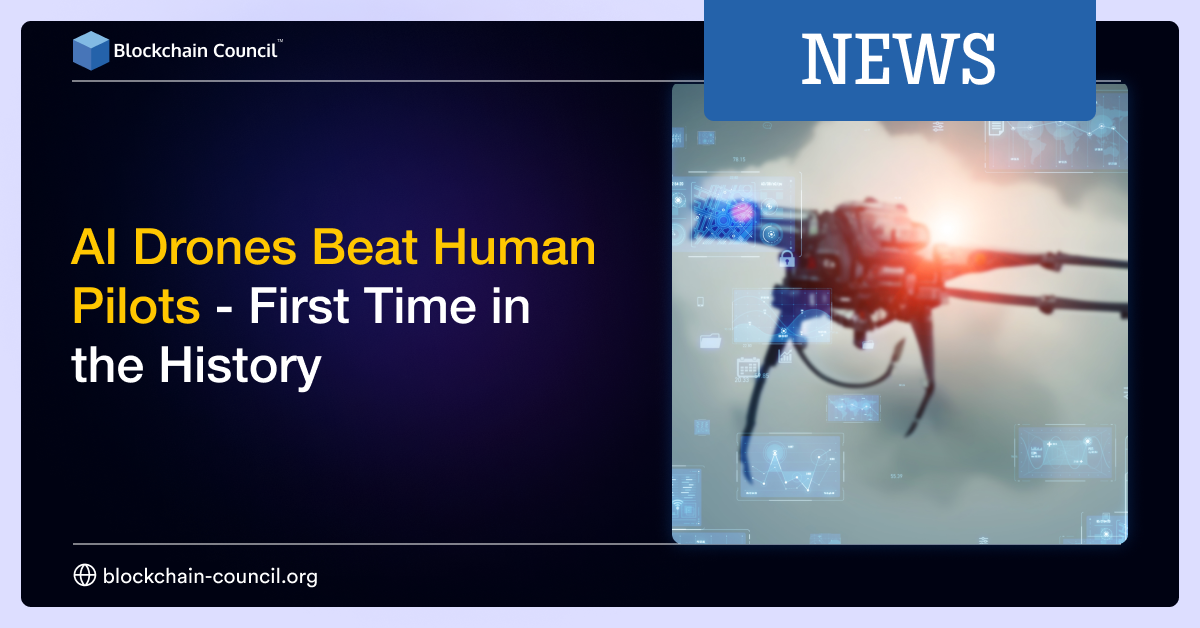
- Blockchain Council
- September 05, 2023
Artificial intelligence (AI) continues to rewrite the boundaries of human achievements across various domains. In a remarkable feat, an AI-powered drone has emerged victorious in a high-speed racing competition, defeating three world-champion human drone pilots. Developed by researchers at the University of Zurich, this AI marvel, known as Swift, has achieved a milestone by winning 15 out of 25 races against human champions and setting a blistering pace on a challenging course where drones reach speeds of up to 50 mph and endure accelerations of up to 5g, the force capable of causing blackouts in humans.
Elia Kaufmann, one of the researchers involved in Swift’s development, expressed the significance of this achievement, stating, “Our result marks the first time that a robot powered by AI has beaten a human champion in a real physical sport designed for and by humans.”
The sport in question is first-person view drone racing, a thrilling competition that involves maneuvering a drone through a course laden with gates that must be cleared without any mishaps. Pilots in this sport rely on a live video feed from a camera mounted on the drone to navigate the course with precision.
The road to victory for Swift was paved with rigorous training. While the human pilots had a week to practice on the actual course, Swift trained in a simulated environment, honing its skills on a virtual replica of the racing circuit. The AI drone employed a technique known as deep reinforcement learning to determine the optimal commands for navigating the course swiftly. This training involved countless crashes, but since it was conducted in a simulated environment, the researchers could reset and refine the learning process.
During the race, Swift’s onboard camera relayed video to a neural network, which detected the racing gates. An inertial sensor provided data on the drone’s position, orientation, and speed. This information was then processed by a second neural network to calculate the necessary commands for the drone.
The analysis of the races unveiled Swift’s strengths and vulnerabilities. The AI consistently displayed faster starts and sharper turns than human pilots, achieving a fastest lap time of 17.47 seconds, half a second quicker than the top human racer. However, Swift was not invincible, losing 40% of its races against humans and experiencing crashes, especially in challenging lighting conditions.
This groundbreaking achievement has left the world champions with mixed emotions. While recognizing the potential of AI in revolutionizing the sport, they also expressed their competitive spirit, with one pilot stating, “This is the start of something that could change the whole world. On the flip side, I’m a racer, I don’t want anything to be faster than me.”
Swift’s capabilities extend beyond the race track. It can adapt to real-world challenges such as aerodynamic turbulence, camera blur, and varying lighting conditions, which are crucial for applications like search and rescue missions or large-scale structural inspections.
While the military sector has a keen interest in AI-powered drones, experts are cautious about immediate applications. The development of AI in the context of autonomous drones for military purposes raises ethical and legal concerns, emphasizing the need for careful consideration of its implications.
Swift’s victory in the world of drone racing marks a significant milestone in the progression of AI technology. It highlights the potential for AI to excel in dynamic and unpredictable physical sports, paving the way for advancements in various industries beyond racing. As AI continues to challenge human capabilities, it prompts us to explore the boundaries of innovation and ethical considerations in this ever-evolving field.





































































 Guides
Guides News
News Blockchain
Blockchain Cryptocurrency
& Digital Assets
Cryptocurrency
& Digital Assets Web3
Web3 Metaverse & NFTs
Metaverse & NFTs
